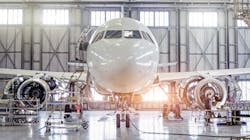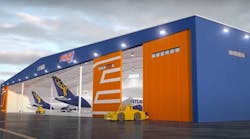Alton Aviation Consultancy has recently updated its global commercial air transport fleet and MRO demand forecast to reflect the post-pandemic industry trends and dynamics. Given the uncertainty surrounding airline industry and passenger demand recovery, 2021 presented unique challenges for Alton’s forecast modelling team.
Key highlights between Alton’s 2019 and 2021 forecasts include:
- Alton’s post-pandemic forecast has been adjusted downward by roughly 10,000 aircraft over the next five years
- The pandemic will dramatically frontload aircraft retirements to historic levels providing an abundance of feedstock for the used serviceable material (USM), market; retirements of widebody aircraft will increase by 63% vs Alton’s pre-pandemic retirement forecast
- As financially challenged airlines defer or cancel new aircraft deliveries in order to conserve cash, the global commercial aircraft average fleet age will increase by ~5%
- The aircraft freighter market will see demand growth for both new production and passenger-to-freighter (P2F) conversions as demand for air cargo continues to grow rapidly driven by the exponential growth of e-Commerce; Alton’s post-pandemic forecast has been adjusted to include an additional 180 freighter aircraft over the next five years.
1.1 Fleet Forecast
Based on our forecasts, we expect the current fleet (active fleet and the portion of inactive fleet that will eventually return to service) to grow from 25,000 aircraft today, reaching 33,000 aircraft by 2026 at a 5.1% compound annual growth rate (CAGR). On a global region basis, Asia Pacific will continue to be the largest market with 33% of the global fleet, followed by North America with 28% and Europe accounting for 20%.
The composition of the global fleet will increasingly become narrowbody dominated. In 2021, 56% of the fleet will comprise Narrowbody aircraft. This share is expected to grow to 65% in 2031, largely as a result of the post-pandemic demand recovery favoring shorter domestic and regional travel, as well as the introduction of more capable narrowbody jets such as the A321XLR that can fly longer distances and take over routes that were once the domain of widebody jets.
1.2 Aircraft Retirement Forecast
Prior to the onset of Covid-19, aircraft retirements were at a 10-year low, averaging approximately 400-450 aircraft per year from 2016-2019 as global air traffic sustained strong growth and new aircraft programs experienced entry-into-services issues. Pre-Covid forecasts suggested a ramp-up in retirements through the 2020s as demographic trends would force steadily increasing retirements from aging fleets.
The pandemic, however, reversed this trend and forced an accelerated retirement schedule that will attenuate over the next five years. At the height of aircraft parking in May 2020, over 18,000 aircraft (68% of the fleet) were inactive, and 8,500 aircraft remained parked at the end of 2020, compared to 2,000 at the beginning of the year. A majority of these still inactive aircraft are not expected to return to service and further fleet rationalizations are expected in the next few years.
A particular casualty of the pandemic is the accelerated demise of the quad-engine aircraft (A380, A340, 747-400). Most acute, Alton revised the retirement forecast rate for the A380 aircraft from 1% to a massive 52% of the global fleet.
1.3 Global MRO Demand Forecast
Alton estimates that during the pandemic in 2020, airlines spent slightly under $49B on MRO, which was roughly half of the spend pre-pandemic. Looking forward, we forecast slightly over $60B of MRO spend in 2021 driven by the robust growth in China and the success of the vaccine roll out in North America which is seeing a commensurate surge in demand for air travel. By 2031, we forecast the global MRO market demand to grow at an 8.4% CAGR to $110B.
In terms of MRO category spend, the largest contributor is in engine MRO, at 44% of total spend in 2021. With a wave of new-generation engine technology (CFM Leap, Pratt and Whitney GTF, Rolls Royce XWBs and Trent 1000s, GE GEnX) replacing the older and more fuel inefficient current generation engine technology (CFM56-5B/7B, IAE V2500-A5, RR Trent 500/700/800. PW4000s, GE CF6-80C2) that will be retired, combined with a nascent USM market for new-generation engine parts, Alton expects the overall share of engine MRO spend to increase to 48% in 2031 after taking into account overall indexed price escalation across all five MRO categories.
A similar picture is revealed when looking at the share of engine overhaul events over the next 10 years. 6%, or 300 engine shop visits, will be generated by new-generation engines in 2021. Shop visits for new-generation engines will overtake current and mature-generation engines in 2029 and will represent 58% of overall engine shop visits by 2031.
As we look to the post-pandemic recovery, Alton also expects modifications spend to grow significantly, with a 7.7% p.a. growth rate, from $3.9B in 2021 to $8.2B in 2031.
1.5 Aircraft Modifications MRO Market
Air travel expectations are changing, and passengers have expressed a preference to engage digitally, placing increased importance on their health and safety across the passenger journey. In response, we expect airlines to continue with modifications spending in targeted areas in the ‘new normal’.
Onboard connectivity will be increasingly available and accessible to the travelling public. With only an estimated 30% of the fleet connectivity-enabled today, Alton expects an increasing pace line-fit installations and retrofits for connectivity. In surveys, passengers have indicated that they would choose a carrier that offers connectivity onboard over another carrier that does not, thus incentivizing carriers to prioritize this service to stimulate near-term demand and increase the airline’s value proposition over the long-term.
Connectivity would also enable wireless IFE that obviates the need for expensive and heavy seatback IFE systems. Passengers are able to stream content, order meal service and access a variety of other airline services from their own personal electronic devices (PEDs).
In addition, airlines will continue to invest in other areas for passenger health and safety, including self-sanitizing bathrooms and anti-microbial monuments and surfaces to prevent the spread of viruses onboard.
Modifications spend in the near term is sustained in the paint and Passenger-to-Freighter (P2F) categories. Paint work will be driven by lease transitions in the short-term from airlines in restructuring to other operators, and in the mid-term as new operators enter the market.
P2F demand stems from the additional air cargo transportation needs brought about by the pandemic. From a demand perspective, the rise of e-commerce and online shopping as a result of pandemic lockdowns have stimulated air cargo demand, and this trend is expected to continue growing through the next decade.
Alton’s post-pandemic forecast has been adjusted to include an additional 180 freighter aircraft over the next 5 years, a 10% increase over our pre-pandemic forecast. Furthermore, P2F conversion economics are now more favorable given the post-pandemic retirement dynamics, especially widebody aircraft, in particular older Boeing 777s and Airbus A330s. That said, Alton estimates that 67% of the P2F conversions will consist of narrowbody aircraft – Boeing 737NGs and Airbus A320ceos.
Over the longer term, conversion demand will be sustained by the changeover in widebody freighters as old A300s, DC-10s and MD-11s are retired, as well as the introduction of narrowbody freighters that can perform point-to-point missions for e-commerce players.
Forecast methodology:
Alton’s proprietary fleet and MRO demand forecast algorithms consist of numerous assumptions and projections to include passenger demand, aircraft retirements, used serviceable material (USM), engine shop visits and green-time usage, cabin upgrades and modifications, passenger-to-freighter (P2F) conversion, and annual OEM catalogue price escalation adjustments, amongst others.



